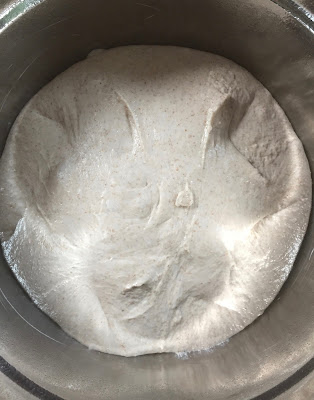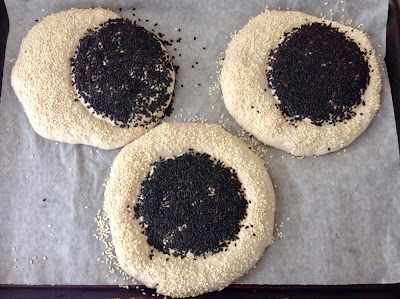Hier geht's zur deutschen Version dieses Posts
This month Mini Oven challenged fellow Fresh Loafers to create a special bread to commemorate the upcoming total eclipse of the sun. Spurred by astronomic ambitions I began to ponder how to go about this.
Just a new bread? Where was the connection to the total eclipse?
A two-toned dough? Once I baked a marbled rye bread and found its taste rather underwhelming.
Squid ink as a black dye? Not my cup of tea!
So it had to be a two-toned decoration. Black and white sesame seeds are in my pantry. Only a suitable recipe was missing. It couldn't be a loaf whose oven-spring would tear and destroy any decorative topping.
The answer was a flat bread that would spread more than rise.
I found a good starting point in Austrian baker Dietmar Kappl's Fladenbrot, tweaking it to suit my needs: with a long, cold bulk fermentation and the introduction of a little whole grain flour (I tried it with rye and emmer - both tasted great).
To emulate the eclipse I needed a ring-shaped utensil to press the outline of the moon into the dough. A large yogurt tub had just the right diameter (11.5 cm/4.5 inches).
We were so happy with my crusty, nutty flat bread that I baked it again, two days later, for my customers at A&B Naturals.
SOLAR ECLIPSE BREAD (adapted from Dietmar Kappl/homebaking.at)
(3 small breads, à 300 g)
Starter
25 g bread flour
25 g emmer flour (or other whole grain flour of your choice)
50 g water (lukewarm)
10 g recently refreshed and active starter (100% hydration)
Final Dough
110 g starter (all)
400 g bread flour
50 g emmer flour (or other whole grain flour)
325 g water, lukewarm
15 g olive oil
10 g salt
1.5 g instant yeast (or 3 g active dry yeast)
Decoration
black and white sesame seeds (or use poppy seeds instead of black sesame)
Specal tool: glass or plastic container with approx. 11-12-cm/4.5-inch diameter, like a large, empty yogurt tub (to imprint the outline of the moon).
DAY 1
In the morning: mix all starter ingredients. Cover, and leave for 4-6 hours at room temperature, or until a few tiny bubbles appear on the surface, and a teaspoon of dough floats in water (float test).
For the final dough, mix all ingredients about 1 minute at low speed until all flour is hydrated. Knead 1 minute at medium speed, let rest for 10 minutes (autolyse), then resume kneading for about 3-4 minutes, until dough pulls somewhat back from sides of bowl (or, for the Ankarsrum, from roller) (dough will be sticky).
Transfer dough to a lightly oiled bowl. Using wet (or oiled) bowl scraper, fold dough all around from sides of bowl to the center (about 8x).
Let dough rest for 10 minutes, then repeat the folding process 2-3 times at 10-minute intervals, until dough has developed enough strength and shows resistance to folding. It will still be a little sticky.
Cover bowl tightly with plastic wrap and place in refrigerator overnight (no need to de-chill).
DAY 2
Preheat oven to 475ºF/250ºC, (including steaming device). Adjust rack to middle position.
Place cold dough (it will still be sticky) on lightly floured work surface. Dust top with a little flour, and divide into 3 equal sized pieces (about 304 g). Shape into rounds.
Place breads, seam-side down, on parchment lined baking sheet. Mist with oil (or mist plastic foil cover with oil) and cover with plastic wrap. Let rest for 45 minutes, or until they are a bit puffed and a dimple, poked with your finger into the dough, remains visible.
Lightly oil the rim of the glass or plastic tub. Press down deep (almost to the bottom) into the dough (breads will spread and flatten.)
Mist breads with water. Using a teaspoon, carefully sprinkle with black sesame (moon shadow) and white sesame (sun.)
Bake breads, with steam, for 10 minutes. Remove steam pan, and reduce temperature to 450ºF/230ºC. Bake for another 10 - 13 minutes, or until breads are golden brown and register at least 200ºF/93ºC.
Let breads cool on a wire rack. (When cooled, they can be frozen, wrapped individually in foil, and placed in a freezer bag. Let come to room temperature, mist with water and re-crisp in the oven at 375ºF/190ºC).
BreadStorm users (also of the free version) can download the formula here:
And this is the perfect music for a Total Eclipse:
This month Mini Oven challenged fellow Fresh Loafers to create a special bread to commemorate the upcoming total eclipse of the sun. Spurred by astronomic ambitions I began to ponder how to go about this.
Just a new bread? Where was the connection to the total eclipse?
A two-toned dough? Once I baked a marbled rye bread and found its taste rather underwhelming.
Squid ink as a black dye? Not my cup of tea!
So it had to be a two-toned decoration. Black and white sesame seeds are in my pantry. Only a suitable recipe was missing. It couldn't be a loaf whose oven-spring would tear and destroy any decorative topping.
The answer was a flat bread that would spread more than rise.
I found a good starting point in Austrian baker Dietmar Kappl's Fladenbrot, tweaking it to suit my needs: with a long, cold bulk fermentation and the introduction of a little whole grain flour (I tried it with rye and emmer - both tasted great).
To emulate the eclipse I needed a ring-shaped utensil to press the outline of the moon into the dough. A large yogurt tub had just the right diameter (11.5 cm/4.5 inches).
We were so happy with my crusty, nutty flat bread that I baked it again, two days later, for my customers at A&B Naturals.
 |
| Baked again for my customers: Solar Eclipse Bread |
SOLAR ECLIPSE BREAD (adapted from Dietmar Kappl/homebaking.at)
(3 small breads, à 300 g)
Starter
25 g bread flour
25 g emmer flour (or other whole grain flour of your choice)
50 g water (lukewarm)
10 g recently refreshed and active starter (100% hydration)
Final Dough
110 g starter (all)
400 g bread flour
50 g emmer flour (or other whole grain flour)
325 g water, lukewarm
15 g olive oil
10 g salt
1.5 g instant yeast (or 3 g active dry yeast)
Decoration
black and white sesame seeds (or use poppy seeds instead of black sesame)
Specal tool: glass or plastic container with approx. 11-12-cm/4.5-inch diameter, like a large, empty yogurt tub (to imprint the outline of the moon).
DAY 1
In the morning: mix all starter ingredients. Cover, and leave for 4-6 hours at room temperature, or until a few tiny bubbles appear on the surface, and a teaspoon of dough floats in water (float test).
 |
| The Ankarsrum makes short work of kneading the dough |
For the final dough, mix all ingredients about 1 minute at low speed until all flour is hydrated. Knead 1 minute at medium speed, let rest for 10 minutes (autolyse), then resume kneading for about 3-4 minutes, until dough pulls somewhat back from sides of bowl (or, for the Ankarsrum, from roller) (dough will be sticky).
 |
| Using wet bowl scraper, fold dough all around from sides to the center |
Transfer dough to a lightly oiled bowl. Using wet (or oiled) bowl scraper, fold dough all around from sides of bowl to the center (about 8x).
Let dough rest for 10 minutes, then repeat the folding process 2-3 times at 10-minute intervals, until dough has developed enough strength and shows resistance to folding. It will still be a little sticky.
Cover bowl tightly with plastic wrap and place in refrigerator overnight (no need to de-chill).
 |
| After 2 sets of folds the dough looks quite smooth already |
DAY 2
Preheat oven to 475ºF/250ºC, (including steaming device). Adjust rack to middle position.
Place cold dough (it will still be sticky) on lightly floured work surface. Dust top with a little flour, and divide into 3 equal sized pieces (about 304 g). Shape into rounds.
 |
| Divide dough in 3 equal pieces and shape into rounds |
Place breads, seam-side down, on parchment lined baking sheet. Mist with oil (or mist plastic foil cover with oil) and cover with plastic wrap. Let rest for 45 minutes, or until they are a bit puffed and a dimple, poked with your finger into the dough, remains visible.
 |
| The moon outline must be deeply imprinted into the dough |
Lightly oil the rim of the glass or plastic tub. Press down deep (almost to the bottom) into the dough (breads will spread and flatten.)
 |
| I tried to create different "stages of the solar eclipse" |
Mist breads with water. Using a teaspoon, carefully sprinkle with black sesame (moon shadow) and white sesame (sun.)
Bake breads, with steam, for 10 minutes. Remove steam pan, and reduce temperature to 450ºF/230ºC. Bake for another 10 - 13 minutes, or until breads are golden brown and register at least 200ºF/93ºC.
Let breads cool on a wire rack. (When cooled, they can be frozen, wrapped individually in foil, and placed in a freezer bag. Let come to room temperature, mist with water and re-crisp in the oven at 375ºF/190ºC).
 |
| Baked solar eclipse! |
BreadStorm users (also of the free version) can download the formula here:
And this is the perfect music for a Total Eclipse:
